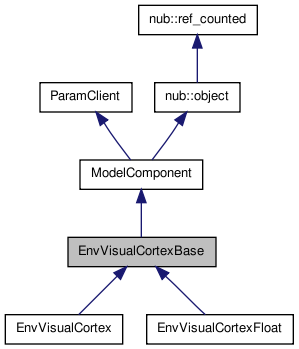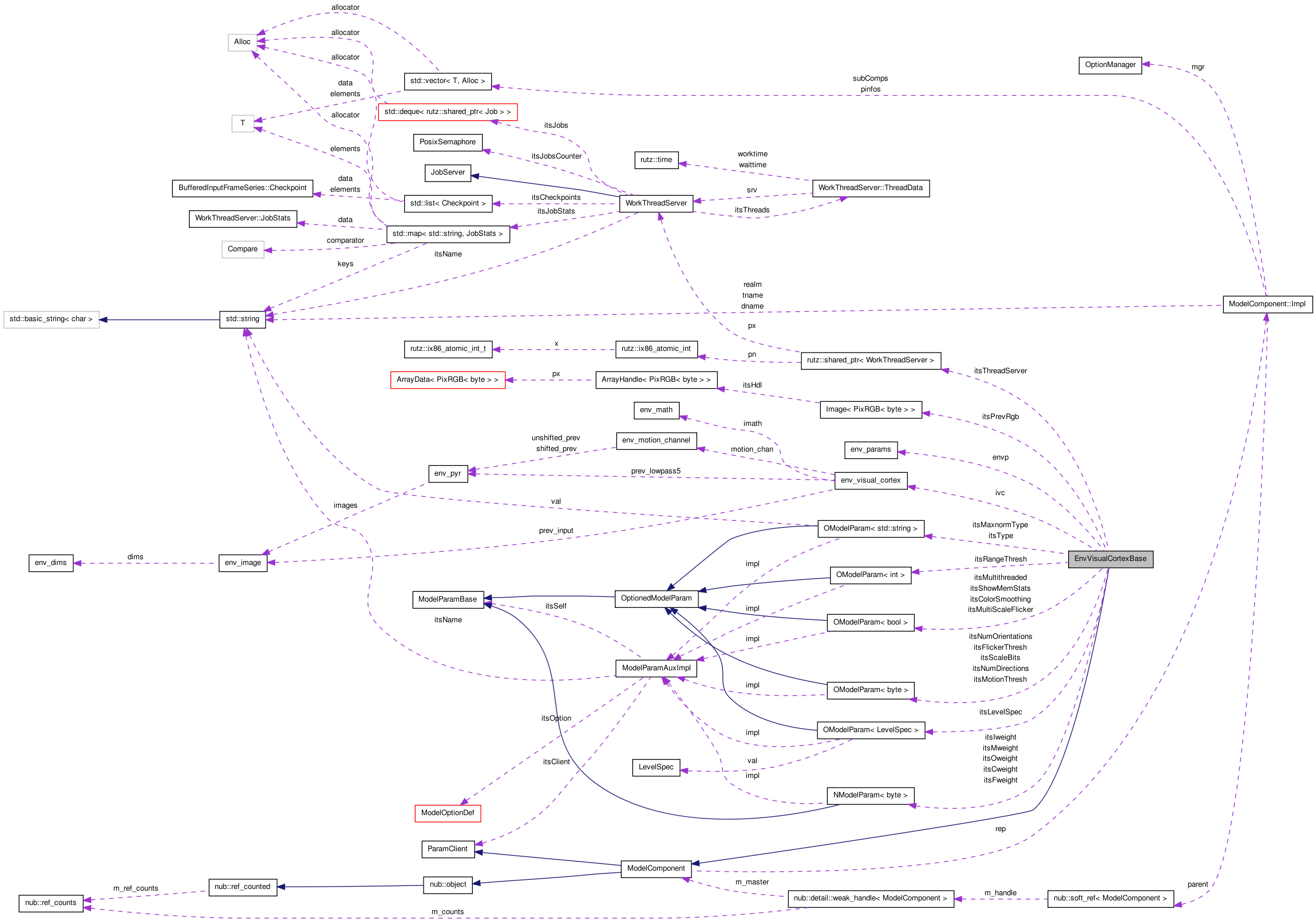

Base class for a VisualCortex using the fast envision saliency computations. More...
#include <Neuro/EnvVisualCortex.H>


Public Member Functions | |
| EnvVisualCortexBase (OptionManager &mgr, const std::string &descrName="EnvVisualCortexBase", const std::string &tagName="EnvVisualCortexBase") | |
| Constructor. | |
| virtual | ~EnvVisualCortexBase () |
| virtual destructor for safe inheritance | |
| env_size_t | getMapLevel () const |
| Return the pyramid level of the saliency map. | |
| virtual void | input (const Image< PixRGB< byte > > &rgbin)=0 |
| Compute saliency map from an input image. | |
| byte | getIweight () |
| byte | getCweight () |
| byte | getOweight () |
| byte | getFweight () |
| byte | getMweight () |
| struct env_params & | getParams () const |
| Access our internal envision parameters. | |
| bool | getColorSmoothing () const |
| void | setColorSmoothing (bool val) |
| void | setIweight (byte val) |
| void | setCweight (byte val) |
| void | setOweight (byte val) |
| void | setNumOrientations (byte val) |
| void | setFweight (byte val) |
| void | setMweight (byte val) |
| void | setFthresh (byte val) |
| void | setMthresh (byte val) |
| void | setMultiScaleFlicker (bool val) |
| void | setNumDirections (byte val) |
| void | setSubmapPreProc (int(*submapPreProc)(const char *tagName, env_size_t clev, env_size_t slev, struct env_image *submap, const struct env_image *center, const struct env_image *surround)) |
| void | setSubmapPostNormProc (int(*submapPostNormProc)(const char *tagName, env_size_t clev, env_size_t slev, struct env_image *submap, const struct env_image *center, const struct env_image *surround)) |
| void | setSubmapPostProc (int(*submapPostProc)(const char *tagName, struct env_image *cmap)) |
Protected Member Functions | |
| virtual void | paramChanged (ModelParamBase *const param, const bool valueChanged, ParamClient::ChangeStatus *status) |
| Called whenever a ModelParamBase has its value changed. | |
| virtual void | start1 () |
| This is called from within start() before the subcomponents start. | |
| virtual void | stop2 () |
| This is called from within stop() after the subcomponents have stopped. | |
Protected Attributes | |
| NModelParam< byte > | itsIweight |
| NModelParam< byte > | itsCweight |
| NModelParam< byte > | itsOweight |
| NModelParam< byte > | itsFweight |
| NModelParam< byte > | itsMweight |
| OModelParam< bool > | itsMultithreaded |
| OModelParam< std::string > | itsMaxnormType |
| OModelParam< byte > | itsScaleBits |
| OModelParam< byte > | itsNumOrientations |
| OModelParam< bool > | itsColorSmoothing |
| OModelParam< byte > | itsNumDirections |
| OModelParam< byte > | itsMotionThresh |
| OModelParam< byte > | itsFlickerThresh |
| OModelParam< int > | itsRangeThresh |
| OModelParam< bool > | itsMultiScaleFlicker |
| OModelParam< bool > | itsShowMemStats |
| OModelParam< LevelSpec > | itsLevelSpec |
| OModelParam< std::string > | itsType |
| struct env_params | envp |
| struct env_visual_cortex | ivc |
| env_size_t | npixels |
| int | framenum |
| Image< PixRGB< byte > > | itsPrevRgb |
|
rutz::shared_ptr < WorkThreadServer > | itsThreadServer |
Base class for a VisualCortex using the fast envision saliency computations.
Definition at line 69 of file EnvVisualCortex.H.
| EnvVisualCortexBase::EnvVisualCortexBase | ( | OptionManager & | mgr, | |
| const std::string & | descrName = "EnvVisualCortexBase", |
|||
| const std::string & | tagName = "EnvVisualCortexBase" | |||
| ) |
Constructor.
Definition at line 243 of file EnvVisualCortex.C.
| EnvVisualCortexBase::~EnvVisualCortexBase | ( | ) | [virtual] |
virtual destructor for safe inheritance
Definition at line 273 of file EnvVisualCortex.C.
References env_allocation_cleanup(), and rutz::shared_ptr< T >::reset().
| env_size_t EnvVisualCortexBase::getMapLevel | ( | ) | const [inline] |
Return the pyramid level of the saliency map.
Definition at line 253 of file EnvVisualCortex.H.
References env_params::output_map_level.
| struct env_params & EnvVisualCortexBase::getParams | ( | ) | const [read] |
Access our internal envision parameters.
Definition at line 261 of file EnvVisualCortex.H.
Compute saliency map from an input image.
Use the getVCXmap(), getImap(), etc to get the results. In the base class input() is pure virtual and the getVCXmap() and others do not exist. Derived classes implement all these and you should use these derived classes.
Implemented in EnvVisualCortex, and EnvVisualCortexFloat.
| void EnvVisualCortexBase::paramChanged | ( | ModelParamBase *const | param, | |
| const bool | valueChanged, | |||
| ParamClient::ChangeStatus * | status | |||
| ) | [protected, virtual] |
Called whenever a ModelParamBase has its value changed.
Subclasses of ModelComponent should override this function if they need to do any internal reconfiguration when their parameters change value (whether due to a command-line option, or a setModelParamString(), or a readParamsFrom()). See OrientationChannel::paramChanged() in Channels/OrientationChannel.C for an example; also see SaccadeControllerConfigurator::paramChanged() in Neuro/SaccadeControllers.C for for how to use this to select subcomponents at runtime.
| param | the address of the ModelParamBase that changed; subclasses can compare this with the addresses of their model param members to figure out which is the relevant param | |
| valueChanged | true if the value actually changed, false if the value was "set" but the new value is the same as the old value; some clients may want to avoid re-doing expensive operations if the value did not actually change | |
| status | the subclass that implements paramChanged() should set *status to CHANGE_REJECTED if it wishes to reject a particular parameter change; the caller of paramChanged() is expected to set *status to CHANGE_ACCEPTED prior to calling paramChanged(), so the implentation of paramChanged() does not need to set *status CHANGE_ACCEPTED if it wishes to allow the change since that will already be the default status |
HISTORICAL NOTE: In the past, subclasses would override setModelParamString() for this same purpose, but in the new setup, setModelParamString() is NOT virtual and hence should not be (cannot be) overridden by subclasses. This setup is cleaner (and potentially more efficient) because subclasses don't have to compare string names to figure out which param changed; instead they are passed the address of the param itself. Furthermore, the new setup is more robust, since we can handle param value changes that come from any source (e.g., setModelParamVal(), or ModelParamBase::setValString(), or OModelParam::setVal()), and not just those that come through setModelParamString().
Reimplemented from ModelComponent.
Definition at line 333 of file EnvVisualCortex.C.
References env_init_pthread_alloc(), ENV_VCXNORM_MAXNORM, ENV_VCXNORM_NONE, rutz::shared_ptr< T >::get(), ModelParamBase::getName(), OModelParam< T >::getVal(), NModelParam< T >::getVal(), env_params::num_orientations, rutz::shared_ptr< T >::reset(), and ModelComponent::started().
| void EnvVisualCortexBase::start1 | ( | ) | [protected, virtual] |
This is called from within start() before the subcomponents start.
Reimplemented from ModelComponent.
Definition at line 281 of file EnvVisualCortex.C.
References LevelSpec::delMax(), LevelSpec::delMin(), env_allocation_init(), env_stdio_assert_handler(), OModelParam< T >::getVal(), LevelSpec::levMax(), LevelSpec::levMin(), LevelSpec::mapLevel(), env_params::num_orientations, env_params::output_map_level, and NModelParam< T >::setVal().
| void EnvVisualCortexBase::stop2 | ( | ) | [protected, virtual] |
This is called from within stop() after the subcomponents have stopped.
Reimplemented from ModelComponent.
Definition at line 319 of file EnvVisualCortex.C.
References env_allocation_get_stats(), OModelParam< T >::getVal(), and invt_allocation_show_stats().
 1.6.3
1.6.3